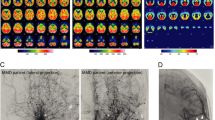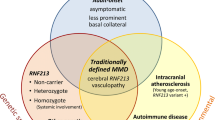Abstract
Background
Focal cerebral arteriopathy includes unifocal or multifocal lesions that are unilateral or bilateral. Large- and/or medium-sized vessels are involved and can be visualized on angiography.
Case report
We report a case of cerebral infarction in a 9-year-old Japanese female who presented with a transient ischemic attack. Steno-occlusion involving the distal part of the internal carotid artery, proximal middle cerebral artery, and anterior cerebral artery was observed. Digital subtraction angiography demonstrated a beaded appearance in the cervical portion of the diseased internal carotid artery. Revascularization surgery was performed 45 days after the onset. A new infarction appeared on the other side of the anterior cerebral artery territory 7 months after the first onset. Antiplatelets and vasodilators were administered, and no progression was observed during 18 months of follow-up. Genetic analysis did not show ring finger protein 213 (RNF213)-related moyamoya disease, and pathological examination revealed no characteristics of fibromuscular dysplasia.
Conclusion
The radiological and genetic features coincided with focal cerebral arteriopathy, which is a distinct entity from fibromuscular dysplasia and RNF213-related moyamoya disease.


Similar content being viewed by others
References
Amlie-Lefond C, Bernard TJ, Sebire G, Friedman NR, Heyer GL, Lerner NB, DeVeber G, Fullerton HJ (2009) Predictors of cerebral arteriopathy in children with arterial ischemic stroke: results of the International Pediatric Stroke Study. Circulation 119:1417–1423
Bernard TJ, Manco-Johnson MJ, Lo W, MacKay MT, Ganesan V, DeVeber G, Goldenberg NA, Armstrong-Wells J, Dowling MM, Roach ES, Tripputi M, Fullerton HJ, Furie KL, Benseler SM, Jordan LC, Kirton A, Ichord R (2012) Towards a consensus-based classification of childhood arterial ischemic stroke. Stroke 43:371–377
Braun KP, Bulder MM, Chabrier S, Kirkham FJ, Uiterwaal CS, Tardieu M, Sebire G (2009) The course and outcome of unilateral intracranial arteriopathy in 79 children with ischaemic stroke. Brain 132:544–557
Fullerton HJ, Wintermark M, Hills NK, Dowling MM, Tan M, Rafay MF, Elkind MS, Barkovich AJ, de Veber GA (2016) Risk of recurrent arterial ischemic stroke in childhood: a prospective international study. Stroke 47:53–59
Kimura H, Hosoda K, Hara Y, Kohmura E (2008) A very unusual case of fibromuscular dysplasia with multiple aneurysms of the vertebral artery and posterior inferior cerebellar artery. J Neurosurg 109:1108–1112
Kirton A, Crone M, Benseler S, Mineyko A, Armstrong D, Wade A, Sebire G, Crous-Tsanaclis AM, de Veber G (2013) Fibromuscular dysplasia and childhood stroke. Brain 136:1846–1856
Liu W, Morito D, Takashima S, Mineharu Y, Kobayashi H, Hitomi T, Hashikata H, Matsuura N, Yamazaki S, Toyoda A, Kikuta K, Takagi Y, Harada KH, Fujiyama A, Herzig R, Krischek B, Zou L, Kim JE, Kitakaze M, Miyamoto S, Nagata K, Hashimoto N, Koizumi A (2011) Identification of RNF213 as a susceptibility gene for moyamoya disease and its possible role in vascular development. PLoS One 6:e22542
Mineharu Y, Takagi Y, Takahashi JC, Hashikata H, Liu W, Hitomi T, Kobayashi H, Koizumi A, Miyamoto S (2013) Rapid progression of unilateral moyamoya disease in a patient with a family history and an RNF213 risk variant. Cerebrovasc Dis 36:155–157
Mineyko A, Kirton A (2013) Mechanisms of pediatric cerebral arteriopathy: an inflammatory debate. Pediatr Neurol 48:14–23
Miyatake S, Miyake N, Touho H, Nishimura-Tadaki A, Kondo Y, Okada I, Tsurusaki Y, Doi H, Sakai H, Saitsu H, Shimojima K, Yamamoto T, Higurashi M, Kawahara N, Kawauchi H, Nagasaka K, Okamoto N, Mori T, Koyano S, Kuroiwa Y, Taguri M, Morita S, Matsubara Y, Kure S, Matsumoto N (2012) Homozygous c.14576G>A variant of RNF213 predicts early-onset and severe form of moyamoya disease. Neurology 78:803–810
Miyawaki S, Imai H, Shimizu M, Yagi S, Ono H, Mukasa A, Nakatomi H, Shimizu T, Saito N (2013) Genetic variant RNF213 c.14576G>A in various phenotypes of intracranial major artery stenosis/occlusion. Stroke 44:2894–2897
Osborn AG, Anderson RE (1977) Angiographic spectrum of cervical and intracranial fibromuscular dysplasia. Stroke 8:617–626
Research Committee on the Pathology and Treatment of Spontaneous Occlusion of the Circle of Willis; Health Labour Sciences Research Grant for Research on Measures for Intractable Diseases (2012) Guidelines for diagnosis and treatment of moyamoya disease (spontaneous occlusion of the circle of Willis). Neurol Med Chir (Tokyo) 52:245–266
Strater R, Becker S, von Eckardstein A, Heinecke A, Gutsche S, Junker R, Kurnik K, Schobess R, Nowak-Gottl U (2002) Prospective assessment of risk factors for recurrent stroke during childhood—a 5-year follow-up study. Lancet 360:1540–1545
Swartz RH, Bhuta SS, Farb RI, Agid R, Willinsky RA, Terbrugge KG, Butany J, Wasserman BA, Johnstone DM, Silver FL, Mikulis DJ (2009) Intracranial arterial wall imaging using high-resolution 3-tesla contrast-enhanced MRI. Neurology 72:627–634
Tolani AT, Yeom KW, Elbers J (2015) Focal cerebral arteriopathy: the face with many names. Pediatr Neurol 53:247–252
Wintermark M, Hills NK, de Veber GA, Barkovich AJ, Elkind MS, Sear K, Zhu G, Leiva-Salinas C, Hou Q, Dowling MM, Bernard TJ, Friedman NR, Ichord RN, Fullerton HJ (2014) Arteriopathy diagnosis in childhood arterial ischemic stroke: results of the vascular effects of infection in pediatric stroke study. Stroke 45:3597–3605
Yeon JY, Shin HJ, Seol HJ, Kim JS, Hong SC (2014) Unilateral intracranial arteriopathy in pediatric stroke: course, outcome, and prediction of reversible arteriopathy. Stroke 45:1173–1176
Author information
Authors and Affiliations
Corresponding author
Ethics declarations
Funding
No sources of financial or material support were gained for conducting this study.
Conflict of interest
The authors declare that they have no conflict of interest.
Informed consent
Informed consent was obtained from the participant included in this case report.
Rights and permissions
About this article
Cite this article
Araki, Y., Takagi, Y., Mineharu, Y. et al. Rapid contralateral progression of focal cerebral arteriopathy distinguished from RNF213-related moyamoya disease and fibromuscular dysplasia. Childs Nerv Syst 33, 1405–1409 (2017). https://doi.org/10.1007/s00381-017-3451-9
Received:
Accepted:
Published:
Issue Date:
DOI: https://doi.org/10.1007/s00381-017-3451-9




